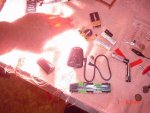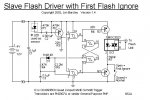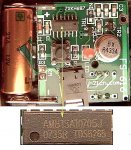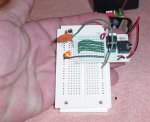If the pictures are blurry in daylight you must be using a pretty slow shutter ... unless the subjects are real fast.
I'm not saying it's impossible. There's a lot of playing you need to do e.g. find out the time delay between your shutter release command and the shutter firing, which may be a big problem esp if Autofocus as delay would be unpredicatable.
If Autofucus is disabled and the delay is exact every time then you're in the game.
Do you have a flash synch socket or hotshoe adaptor? Measuring synch pulse to (connected) flash may be a useful figure too.
You my be able to do it with a single RF blip with the right gear - and miles away from Dr-Acula with his 15MWatt Beijing transmitters

which will be transmitting on every frequency inc 434.
The main problem as I can see using the normal RF modules with data is the 'delay to stable data' figure on Rx modules and then a serin response time or even with HT12E/D there is quite a delay.
I'd also consider single blip with microwave modules too. Signal/ratio will be much better for single blip and you can get Tx/Rx devices with no middle-man electronics so you can tap into the bare signal. I don't know whther it would work, I'm just throwing suggestions to you. (i.e. thinking out aloud).
Whilst delays can be compensated for, the prob is that the longer they are then the more likely you are to get out of synch. If there any inconsistencies then you're muggered.
Actually sounds like a fun project. I wish I was doing it.
Are there not devices on the market already? I haven't looked.
If you can be bothered, then good luck. Very interesting project.
PS. You'll need a good 'scope.








